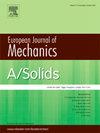板料深拉深力预测的迁移学习方法
IF 4.2
2区 工程技术
Q1 MECHANICS
引用次数: 0
摘要
深拉深过程涉及几何、物理和边界条件之间高度非线性相互作用的复杂变形。拉深力(DDF)是指冲压件在成形过程中施加在板料上的力,对于机械设计和预测起皱或断裂等失效模式至关重要。本研究提出了一种数据驱动的迁移学习框架来预测各种工艺条件下的DDF,将从分析生成的数据中学习到的知识转移到由有限的数值或实验数据训练的模型中,有效地减少了数据需求,同时保持了较高的预测精度。这项工作中的迁移学习完全是数据驱动的,依赖于分析生成的数据来预训练基本模型。具体而言,利用基于能量法的理论成形力方程生成大型合成数据集进行预训练。然后利用少量经过实验验证的高保真有限元法(FEM)结果对基础模型进行微调,最后通过未知有限元数据的测试来评估预测性能。预先训练的知识也被转移到涉及不同几何形状零件的任务中,显示出较强的泛化能力。实验结果表明,迁移学习框架在降低数据需求的同时显著提高了预测精度,为深冲过程建模提供了一种高效、经济的解决方案。本文章由计算机程序翻译,如有差异,请以英文原文为准。
A Transfer Learning method for deep drawing force prediction of sheet metal
The deep drawing process involves complex deformations with highly nonlinear interactions among geometry, physics, and boundary conditions. Deep Drawing Force (DDF) refers to the force exerted by the punch on the sheet during forming and is essential for mechanical design and the prediction of failure modes such as wrinkling or fracture. This study proposes a data-driven transfer learning framework to predict DDF under various process conditions, where knowledge learned from analytically generated data is transferred to a model trained on limited numerical or experimental data, effectively reducing the data requirement while maintaining high prediction accuracy. The transfer learning in this work is entirely data-driven and relies on analytically generated data to pre-train a base model. Specifically, a large synthetic dataset is generated for pre-training using theoretical forming force equations based on the energy method. This base model is then fine-tuned using a small number of high-fidelity Finite Element Method (FEM) results that have been experimentally validated, finally, the prediction performance is evaluated by testing on unknown FEM data. The pre-trained knowledge is also transferred to tasks involving parts with different geometries, demonstrating strong generalization capability. Experimental results show that the transfer learning framework significantly improves prediction accuracy while reducing data requirements, offering an efficient and cost-effective solution for deep drawing process modelling.
求助全文
通过发布文献求助,成功后即可免费获取论文全文。
去求助
来源期刊
CiteScore
7.00
自引率
7.30%
发文量
275
审稿时长
48 days
期刊介绍:
The European Journal of Mechanics endash; A/Solids continues to publish articles in English in all areas of Solid Mechanics from the physical and mathematical basis to materials engineering, technological applications and methods of modern computational mechanics, both pure and applied research.

 求助内容:
求助内容: 应助结果提醒方式:
应助结果提醒方式:


